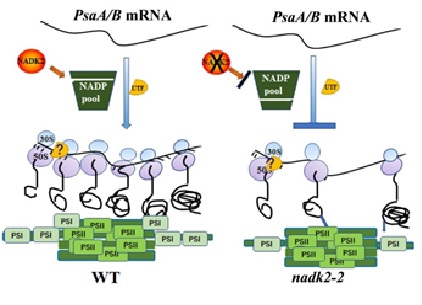In oxygenic photosynthesis, the Photosystem (PSI) complex plays an important role in the electronic transport, reducing power partition and response to dynamic fluctuations of light intensity. Although the PSI structure and function are well understood, the mechanism for PSI biogenesis in vivo is still largely unknown.
A research group led by Prof. Wei Chi from the Institute of Botany of CAS has revealed a novel mechanism for PSI synthesis depending on NADP+ pool in chloroplasts of high plants, which has been published in Plant Physiology recently.
The researchers identified nadk2 mutant line in Arabidopsis, which is disrupted in the synthesis of NADP+ from NAD+ and leading to a smaller NADP pool size in mutant chloroplasts.
They observed that photosystem II (PSII) of the nadk2 mutant is highly sensitive to light, but the reaction center of PSII is only mildly affected compared to the wild type.
Via chlorophyll fluorescence analysis, researchers indicated that the primary limitation of the photosynthetic electron transport even at low light intensities occurs at PSI rather than at PSII in the nadk2 mutant.
According to in vivo labeling and pulse-chase experiments, the de novo synthesis of the two PSI core subunits PsaA and PsaB were impaired, causing the deficiency of the PSI complex in nadk2.
They subsequently used Northern and Polysome loading to investigate the translation efficiency of the psaA-psaB-rps14 mRNA and observed reduction in translation efficiency of psaA/B in nadk2.
This study reveals an unexpected molecular link between NADK activity and mRNA translation of psaA/B in chloroplasts that may mediate a feedback mechanism to adjust de novo biosynthesis of the PSI complex in response to a variable NADPH demand. This adjustment may be important to protect PSI from photoinhibition under conditions that favor acceptor side limitation.
This novel mechanism depending on NADPH might be benefic to improve crop light acclimatation via the genetic approach.

The PSI synthesis was regulated by NADP pool size.(Image from IBCAS)
Article Link: https://academic.oup.com/plphys/advance-article/doi/10.1093/plphys/kiac161/6564234?login=true
Contact:
CHI Wei
Institute of Botany, Institute of Botany, the Chinese Academy of Sciences
Email: chiweimr@ibcas.ac.cn
In oxygenic photosynthesis, the Photosystem (PSI) complex plays an important role in the electronic transport, reducing power partition and response to dynamic fluctuations of light intensity. Although the PSI structure and function are well understood, the mechanism for PSI biogenesis in vivo is still largely unknown.
A research group led by Prof. Wei Chi from the Institute of Botany of CAS has revealed a novel mechanism for PSI synthesis depending on NADP+ pool in chloroplasts of high plants, which has been published in Plant Physiology recently.
The researchers identified nadk2 mutant line in Arabidopsis, which is disrupted in the synthesis of NADP+ from NAD+ and leading to a smaller NADP pool size in mutant chloroplasts.
They observed that photosystem II (PSII) of the nadk2 mutant is highly sensitive to light, but the reaction center of PSII is only mildly affected compared to the wild type.
Via chlorophyll fluorescence analysis, researchers indicated that the primary limitation of the photosynthetic electron transport even at low light intensities occurs at PSI rather than at PSII in the nadk2 mutant.
According to in vivo labeling and pulse-chase experiments, the de novo synthesis of the two PSI core subunits PsaA and PsaB were impaired, causing the deficiency of the PSI complex in nadk2.
They subsequently used Northern and Polysome loading to investigate the translation efficiency of the psaA-psaB-rps14 mRNA and observed reduction in translation efficiency of psaA/B in nadk2.
This study reveals an unexpected molecular link between NADK activity and mRNA translation of psaA/B in chloroplasts that may mediate a feedback mechanism to adjust de novo biosynthesis of the PSI complex in response to a variable NADPH demand. This adjustment may be important to protect PSI from photoinhibition under conditions that favor acceptor side limitation.
This novel mechanism depending on NADPH might be benefic to improve crop light acclimatation via the genetic approach.

The PSI synthesis was regulated by NADP pool size.(Image from IBCAS)
Article Link: https://academic.oup.com/plphys/advance-article/doi/10.1093/plphys/kiac161/6564234?login=true
Contact:
CHI Wei
Institute of Botany, Institute of Botany, the Chinese Academy of Sciences
Email: chiweimr@ibcas.ac.cn
